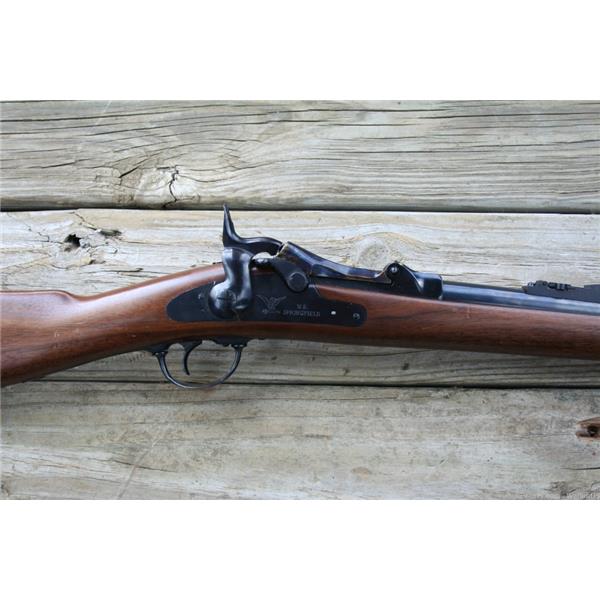

The Board adopted the National Armory’s (a.k.a. Single-shot rifles were thought to force a more efficient use of ammunition.The Board’s priority of long-range accuracy over rate of fire.It looked similar to proven guns of the past, especially with its pronounced hammer.Single shots were viewed as more reliable and rugged than repeaters or magazine rifles.(Money was an important factor given the War Department’s newly slashed budget.) It used existing materials, thereby saving money and manufacturing time.This appealed to the Board for a number of reasons: Allin, was to take the existing Civil War muzzle-loaders, of which there were thousands, and convert them by adding the now well-known “trap door” to the receiver. The idea of the Master Armorer at the U.S. This led to the formation of an Army Board who, in 1865, would host trials for different rifles by makers both foreign and domestic. To be specific, it wanted a breech-loading rifle that would chamber a self-primed, metallic cartridge. Rare Early Springfield Armory Model 1873 Trapdoor Rifle with Rare Metcalfe Device Breech from above of the Officer’s Model 1875 Origins…What Role Did the Springfield Trapdoor Play in History?Īfter the Civil War, the War Department wanted a breech-loading rifle. Today we discover a bit more of this rifle, its origins, the question of its performance, and its role in history. Militarily, it represents the watershed transition for U.S. It also played a role in the wars against the Native Americans. The Springfield Trapdoor would kill buffalo by the thousands as America expanded westward. The rifle would take its place in history just after the Civil War-despite the justifiable hesitation of many military personnel who were all too aware of the superiority of repeaters and magazine fed rifles. Produced for over 20 years, the Springfield Trapdoor experienced many changes throughout its life.

45-70 – or 55 grains of powder for the lighter cavalry carbine.In terms of American military long arms, very little attention is given to a predecessor of the much-heralded M1903 and M1 Garand, the Springfield Trapdoor. 45 cartridge was loaded with a 405-grain bullet and 70 grains of black powder for infantry rifles – the reason it became known as the. 45-caliber round, screwed into a trapdoor “action.” The. Instead it featured a separate barrel chambered for a new. The Model 1870 was replaced in 1873 by a new trapdoor Springfield, which was not a converted muzzleloader. 50-70 conversion went through several variations from 1866 to 1870, when both an infantry rifle and cavalry carbine were produced.

50-70 conversion was a success, and its first major action was the famous Wagon Box Fight of 1867 in present-day Wyoming, where a handful of soldiers from nearby Fort Phil Kearny, along with a few civilians, held off several hundred Indian warriors led by Lakota (Sioux) Chief Red Cloud, thanks in part to the rapid repeat fire from the cartridge rifles. (The original barrel length of the muzzleloaders was 40 inches, but the breechblock reduced that to 36.6 inches.) 50-70 cartridge using a 450-grain bullet and 70 grains of Fg black, resulting in 1,260 fps from the 36.6-inch barrel. 50 caliber and chambered for the new centerfire. 58’s ballistics were comparatively wimpy due to the pressure limitations of the copper rimfire case, while the smaller parts of the breechblock were complicated and failed too often.Ĭonsequently, in 1866 the second Allin conversion appeared with a less complicated breechblock, including a U-shaped spring extractor that flung fired cases out of the chamber, whereupon they hit a wedge-shaped steel block in the “trough” behind the chamber, launching them into the air. These rifles were called the Model of 1865, but unfortunately the. 58 rimfire cartridge loaded with a 480-grain bullet and 60 grains of black powder. The first trapdoor Springfields were 5,000 muzzleloaders chambered for a. Alexander Dyer, Chief of Ordnance, but Allin assured the general the Army could use his design without paying royalties. Allin personally patented his system in 1865, unbeknownst to Gen. His design removed a few inches off the top of the rear end of the barrel the gap was then fitted with a steel breechblock hinged at the front (hence the nickname “trapdoor”) containing an angled firing pin. Allin, master armorer at Springfield Armory. Several people came up with workable conversions, but the winner was developed by Erskine S.


 0 kommentar(er)
0 kommentar(er)
